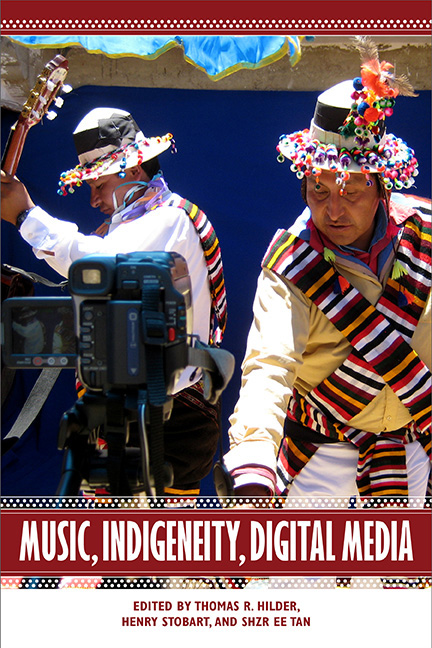Book contents
- Frontmatter
- Dedication
- Contents
- List of Illustrations
- Acknowledgments
- Music, Indigeneity, Digital Media: An Introduction
- 1 Taiwan's Aboriginal Music on the Internet
- 2 Recording Technology, Traditioning, and Urban American Indian Powwow Performance
- 3 YouTubing the “Other”: Lima's Upper Classes and Andean Imaginaries
- 4 An Interview with Russell Wallace
- 5 Mixing It Up: A Comparative Approach to Sámi Audio Production
- 6 Creative Pragmatism: Competency and Aesthetics in Bolivian Indigenous Music Video (VCD) Production
- 7 Keepsakes and Surrogates: Hijacking Music Technology at Wadeye (Northwest Australia)
- 8 The Politics of Virtuality: Sámi Cultural Simulation through Digital Musical Media
- Selected Bibliography
- List of Contributors
- Index
5 - Mixing It Up: A Comparative Approach to Sámi Audio Production
Published online by Cambridge University Press: 26 April 2018
- Frontmatter
- Dedication
- Contents
- List of Illustrations
- Acknowledgments
- Music, Indigeneity, Digital Media: An Introduction
- 1 Taiwan's Aboriginal Music on the Internet
- 2 Recording Technology, Traditioning, and Urban American Indian Powwow Performance
- 3 YouTubing the “Other”: Lima's Upper Classes and Andean Imaginaries
- 4 An Interview with Russell Wallace
- 5 Mixing It Up: A Comparative Approach to Sámi Audio Production
- 6 Creative Pragmatism: Competency and Aesthetics in Bolivian Indigenous Music Video (VCD) Production
- 7 Keepsakes and Surrogates: Hijacking Music Technology at Wadeye (Northwest Australia)
- 8 The Politics of Virtuality: Sámi Cultural Simulation through Digital Musical Media
- Selected Bibliography
- List of Contributors
- Index
Summary
In 1989, in a significant article on “Globalization as Philosophical Issue,” cultural theorist Fredric Jameson elaborated some of the tensions between aspects of what he has identified throughout much of his career as “late capitalism.” Noting that the extent to which world markets now require “a global division of labour on an extraordinary scale,” he observes that, on the one hand, cultural difference can be asserted and celebrated to a larger extent than ever before, but, on the other, standardization on an unparalleled scale threatens “forced integration into a world system.” He clearly inclines to the latter (pessimistic) side of the equation, observing that “American mass culture, associated as it is with money and commodities, enjoys a prestige that is perilous for most forms of domestic cultural production.” While, like many ethnomusicologists, I am motivated to emphasize the distinctiveness and agency of local cultures, this article recognizes that it is less useful to take sides on the issue of standardization than to attempt to understand the intertwining factors that impinge on local cultural production. The attention I pay here to comparative recording aesthetics addresses such factors in relation to issues examined in the anthology's introduction. I explore, to some extent, the way contemporary Sami musicians have used the opportunities that modernity has presented in order to resist marginalization by drawing upon local aesthetics, indices of place as well as styles of social interaction, and archival memory. I agree with Wilson and Stewart's statement that “the major executives of the hegemonic media do not always define the terms of ‘excellence’ for Indigenous media makers. Indigenous artists and activists are using new technologies to craft culturally distinct forms of communication and artistic production that speak to local aesthetics and local needs while anticipating larger audiences.” By emphasizing comparative responses to distinct Indigenous processes, however, I hope to nuance the discussion, challenging a simplistic idea of “resistance” by insisting on the complex array of social contingencies, media memory, styles of relationality and cultural values that contribute to the divergent “readings” of Indigenous audio production in the digital era.
- Type
- Chapter
- Information
- Music, Indigeneity, Digital Media , pp. 106 - 126Publisher: Boydell & BrewerPrint publication year: 2017



